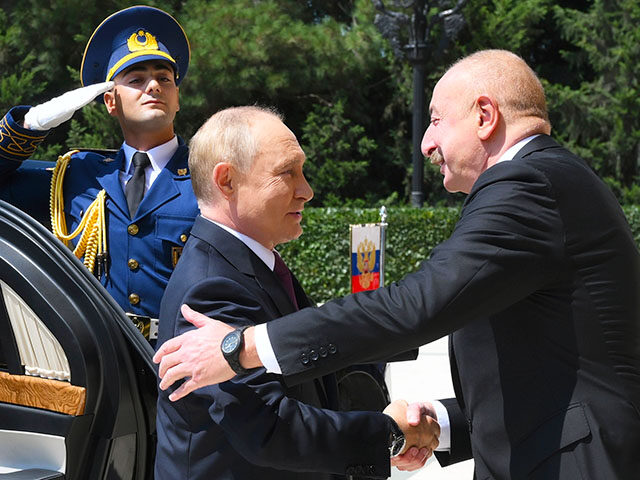Russian President Vladimir Putin arrived in Azerbaijan on Sunday for a two-day state visit, looking to bolster Russia’s relationship with the aggressive Islamist power even as relations with Armenia — Russia’s former best friend in the region — deteriorate.
Azerbaijan is on the relatively short list of countries Putin can visit safely, as he faces an outstanding warrant for his arrest on war crimes charges related to his invasion of Ukraine. Azerbaijan is not a signatory to the treaty that established the International Criminal Court (ICC), so it has no legal obligation to arrest him.
WATCH — Tom Cotton: “Putin Only Invades Ukraine When Democrats Are President”:
Putin’s visit comes at a bad moment for Russian military pride, as Ukraine is now almost three weeks into a surprising border incursion that has brought several Russian towns under Kyiv’s control. Armenia already had a very low opinion of Russia’s ability to protect vulnerable borders.
The Armenians are seething because Russia did not lift a finger to prevent Azerbaijan from seizing, and ethnically cleansing, the disputed Nagorno-Karabakh region in September 2023. Russia deployed “peacekeepers” to the area after brokering a truce in the Armenia-Azerbaijan war of 2020, but they merely stood by and watched as Azeri troops rolled in, then packed up their gear and headed off for the front lines in Ukraine.
Nagorno-Karabakh was rated the most unfree region in the entire world by Freedom House six months after the Azerik conquest. Freedom House noted the Armenian Christian population was already sick, hungry, impoverished, and terrorized from a brutal Azeri blockade before the conquering army rolled in and forced most of them to flee.
In June, Armenian Prime Minister Nikol Pashinyan announced his country would withdraw from the Collective Security Treaty Organization (CSTO), Russia’s regional security bloc. Pashinyan said the CTSO had not “fulfilled its objectives as far as Armenia is concerned” when it allowed Azerbaijan to first isolate, and then conquer, the Nagorno-Karabakh region.
In July, Armenia enraged Russia by authorizing a joint military exercise with a small American force. The 11-day exercise, called Operation Eagle Partner, was seen as a landmark in Armenia’s turning away from Russia and toward the Western world.
“The appearance of the Americans in the South Caucasus, we have already seen this repeatedly in various parts of the world, will only fuel the conflict potential persisting in the region, and create new dividing lines,” Russian Foreign Ministry spokeswoman Maria Zakharova fumed in July.
“Western countries are maniacally dragging Armenia into various formats of interaction in Transcaucasia,” she said.
U.S. Under-Secretary of State Uzra Zeye countered that the United States saw no evidence to “indicate that Russia’s military presence contributes to a more peaceful and stable South Caucasus region.”
Putin said on Monday that he wanted to broker a new truce between Azerbaijan and Armenia, but his visit looked more like a signal that Russia is moving on and seeing other countries after a messy divorce from Armenia.
“If we can do something to get a truce signed between Armenia and Azerbaijan, achieve the delimitation and demarcation of the border, as you and I discussed many times, and unblock the relevant tracks in logistics and the economy, we will be very glad to do so,” Putin said at the beginning of his talks with Azerbaijan’s President Ilham Aliyev.
The Kremlin said the agenda for Putin’s state visit includes developing the “Russia-Azerbaijan strategic partnership and alliance,” as well as resolving “relevant international and regional issues,” such as simmering hostility between Azerbaijan and Armenia.
Russian officials have been warning Armenia that allowing Western powers into what Russia sees as its natural Soviet-era sphere of influence will not be tolerated. Most of what Armenia has done so far could be described as signals of displeasure, symbolic gestures that do not permanently change its relationship with Russia, which remains its largest trading partner.
The European Union began making overtures to Armenia in March, including offers of political support and modest funding for infrastructure projects. Armenia’s neighbors, including Iran and Turkey, joined Russia in warning it not to seek deeper entanglements with Europe and the United States.
After what happened in Nagorno-Karabakh, it is not surprising for Armenians to conclude they cannot rely on Russia for protection if Azerbaijan decides to grab more territory. Geopolitical analysts have noted that younger Armenians are growing more pro-Western in their outlook, a process accelerated by the sense that Moscow takes Armenia’s loyalty for granted while seeking a closer strategic partnership with Azerbaijan.
Pro-Russian parties in Armenia have all but vanished, and while Pashinyan is not terribly popular – especially among Armenians who blame him for losing Nagorno-Karabakh – his opponents have even lower approval ratings.
The Moscow Times in June quoted Russian officials who said Armenia will probably complete the process of withdrawing from the CSTO, a significant embarrassment for Moscow and a challenge to Russia’s view of its security priorities in the South Caucasus. Russia has long viewed Armenia as a vital bulwark against the NATO member next door, Turkey.
“This region will have to be secured by someone, and it will be impossible to rely on the Armenian army in the CSTO format. However, Russia has no other ally in the South Caucasus,” a Russian official grumbled to the Moscow Times.

COMMENTS
Please let us know if you're having issues with commenting.